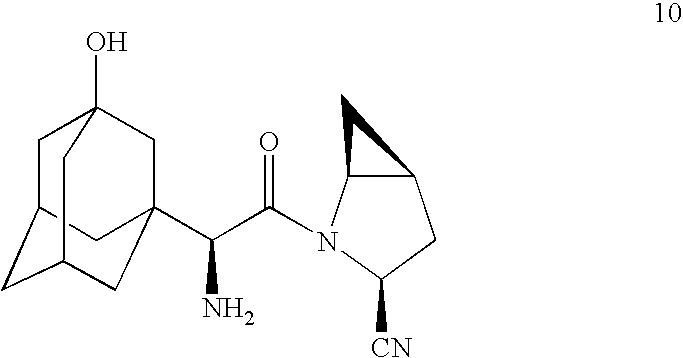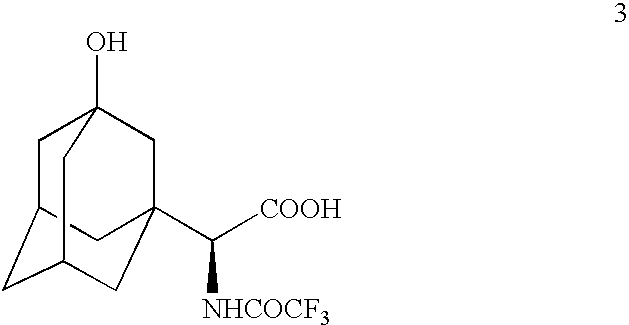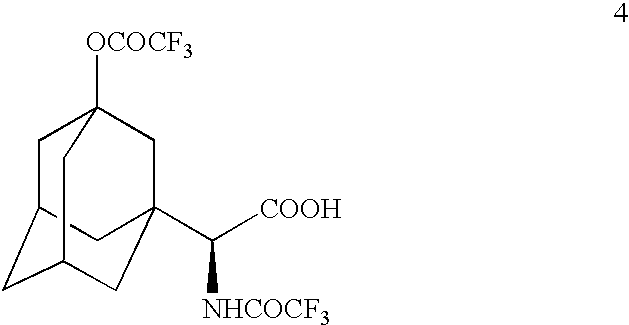Process for preparing a dipeptidyl peptidase IV inhibitor and intermediates employed therein
a technology of dipeptidyl peptidase and intermediates, which is applied in the field of preparing dipeptidyl peptidase iv inhibitors and intermediates produced therein, can solve the problem of too rapid degradation of exogenous peptides for continual therapeutic us
- Summary
- Abstract
- Description
- Claims
- Application Information
AI Technical Summary
Benefits of technology
Problems solved by technology
Method used
Image
Examples
example 1
Preparation of
[0102]
from
[0103]
[0104]The HCl salt 2 (26.1 g, 1 equiv) was added as a solid in one portion to a suspension of potassium methoxide (22.8 g, 3.1 equiv) in methanol (228 mL). Ethyl trifluoroacetate (29.8 g, 24.9 mL, 2.1 equiv) was added slowly to the reaction mixture and the mixture was stirred at room temperature for 15 minutes. HPLC suggested the completion of reaction. A solution of concentrated HCl (12 g), NaCl (1.44 g) and water (130 mL) was added to the reaction mixture and stirred for 15 minutes. The reaction mixture was concentrated under reduced pressure leaving an aqueous layer. Ethyl acetate (100 mL) was added followed by a solution (100 mL) of conc. HCl (12 g), NaCl (1.44 g) and water (130 mL). The aqueous layer was separated and re-extracted with ethyl acetate (3×50 mL). The combined organic layers were washed with brine (2×50 mL), dried (MgSO4) and filtered. The filtrate was concentrated under reduced pressure to leave an oily residue. The residue was tritur...
example 2
Preparation of
[0105]
A. From
[0106]
[0107]TFAA (110 mL) was added to compound 3 (22.8 g) and the resulting solution was stirred at room temperature under nitrogen atmosphere for 2 h until HPLC showed the completion of reaction. The reaction mixture was cooled to −30° C. and quenched by a dropwise addition of water (150 mL) maintaining the reaction temperature below 0° C. (exotherm). The reaction mixture was diluted by the addition of dichloromethane (150 mL) and was stirred for 5 minutes. The organic layer was separated and the aqueous layer was re-extracted with dichloromethane (3×50 mL). The combined organic layers were washed with brine (3×50 mL), dried (MgSO4) and concentrated to leave a residue, 20.3 g, 68.5% crude yield. The residue was purified by column chromatography eluting with a mixture of dichloromethane-methanol (98:2) to give title compound 4, 16.07 g, 96% pure, 54.3% yield. CIMS: m / z 440 (M+Na); ESI: m / z 440 (M+Na)+, 462 (M−H+2Na)+, 879 (2M−H+2Na)+, 895 (2M−H+K+Na)+, 90...
example 3
Direct conversion of
[0113]
reaction mixture to
[0114]
A. Preparation of
[0115]
from
[0116]
reaction mixture
[0117]A bioconversion mixture (80 mL) containing 8.0 g of free base 1
[0118]
(1.0 equiv) was added to a 500-mL flask. THF (80 mL) was added and the pH of the mixture was adjusted to 9.0 using 10 N NaOH. CH3(CH2)11SCOCF3 (52.8 g, 5.0 equiv) was then added and the mixture was heated to 55–60° C. The reaction mixture was stirred at 55–60° C. for 5.5 h, until 1H NMR indicated the absence of starting material 1 in the reaction mixture. During this time the pH was maintained at 8.5–9.0 using 10 N NaOH. The reaction mixture was cooled to 20–25° C. and THF was removed under vacuum leaving an aqueous layer. Isopropyl acetate (140 mL) was added and the pH of the mixture was adjusted to 2.0 using 35% aq. H2SO4 followed by the addition of Celite (4 g). The mixture was then filtered through a 4 g pad of Celite and the cake was washed with isopropyl acetate (80 mL). The pH of the filtrate was re-adju...
PUM
| Property | Measurement | Unit |
|---|---|---|
| molar ratio | aaaaa | aaaaa |
| molar ratio | aaaaa | aaaaa |
| temperature | aaaaa | aaaaa |
Abstract
Description
Claims
Application Information
 Login to View More
Login to View More - R&D
- Intellectual Property
- Life Sciences
- Materials
- Tech Scout
- Unparalleled Data Quality
- Higher Quality Content
- 60% Fewer Hallucinations
Browse by: Latest US Patents, China's latest patents, Technical Efficacy Thesaurus, Application Domain, Technology Topic, Popular Technical Reports.
© 2025 PatSnap. All rights reserved.Legal|Privacy policy|Modern Slavery Act Transparency Statement|Sitemap|About US| Contact US: help@patsnap.com



